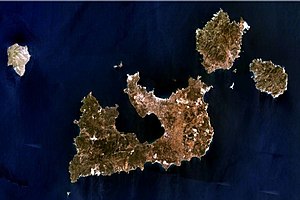Polyegos
| Polyegos | ||
|---|---|---|
| Milos, Kimolos (top center), Polyegos (right) and Andimilos (left) | ||
| Waters | Mediterranean Sea | |
| Archipelago | Cyclades | |
| Geographical location | 36 ° 46 '21 " N , 24 ° 38' 18" E | |
|
|
||
| length | 6 km | |
| width | 4.2 km | |
| surface | 18.146 km² | |
| Highest elevation | Strongylo 370 m |
|
| Residents | 2 (2011) <1 inh / km² |
|
Polyegos ( Greek Πολύαιγος [ pɔˈliɛɣɔs ] ( f. Sg. )) Is a Greek island in the Aegean Sea , on which in 2011 two inhabitants were counted. The island belongs to the Cyclades and is located about 150 kilometers southeast of Athens and 140 kilometers north of the island of Crete . In the Middle Ages it was also referred to as Polyvos (Πόληβος), Polinos (Πόληνος) and Ipolivos (Ηπόληβος); her Venetian name was Brusiata ('the burnt one').
Polyegos is only a two kilometer wide strait away from the neighboring island of Kimolos ; the larger neighboring island of Milos is about six kilometers to the west. There are other, much smaller, uninhabited islands between the three islands.
The island is six kilometers long, up to 4.2 kilometers wide and has a surface of about 18 km². The rocky island, which, like the rest of the islands of the Milos Archipelago, is of volcanic origin, reaches a height of 370 meters (Strongylo); north-west of it is the Psilo Vouno (300 m). The rocky coast offers few natural harbors, only in the north and in the west two small bays allow the mooring of boats.
It has only sparse vegetation, which mainly consists of phrygana and bushes. There are also some species endemic to Greece such as Serapias carica var. Monantha . Wild goats and rabbits live on the island, the rocks are important as a bird area, a rare species of reptile that lives on the island is the Cycladic viper . The cave-rich coast is also home to the Mediterranean monk seal .
The island is designated as a Site of Community Importance by the Natura 2000 program .
On Polyegos there are the remains of two trachyte quarries that were used for the production of millstones. Silver deposits were found on the island at the end of the 19th century.
The island has been uninhabited for most of its history. Medieval reports mention agriculture in the form of olives, wine, grain and cotton, which, however, was apparently destroyed by the Venetians during their clashes with the Ottoman Empire in the 17th century. In 1622 a monastery of the Dormition of the Blessed Mother was founded, the ruins of which can be found in the northwest. In 1898 a lighthouse was built at Cape Maskoula in the northeast of the island. There are also ruins of some abandoned huts. In 1951, 14 people were still registered as residents of the island. The island has changed hands frequently since the Middle Ages; today it is partly owned by the church and partly privately owned.
During the holiday season, Polyegos can be reached by kaíkis or excursion boats from Milos or Kimolos. There are no sights, but there are some places where you can swim or dive.
| year | 1940 | 1951 | 1961 | 1971 | 1981 | 1991 | 2001 | 2011 |
|---|---|---|---|---|---|---|---|---|
| Residents | 10 | 14th | 6th | 4th | 1 | - | 0 | 2 |
Web links
- Presentation of the island through the Aegean portal www2.egeonet.gr ( PDF , 273 kB, Greek)
Individual evidence
- ↑ a b Results of the 2011 census, Greek Statistical Office (ΕΛ.ΣΤΑΤ) ( Memento from June 27, 2015 in the Internet Archive ) (Excel document, 2.6 MB)
- ↑ Population development of Polyegos 1940–2011, Greek Statistical Office ELSTAT, digital library (Greek)

